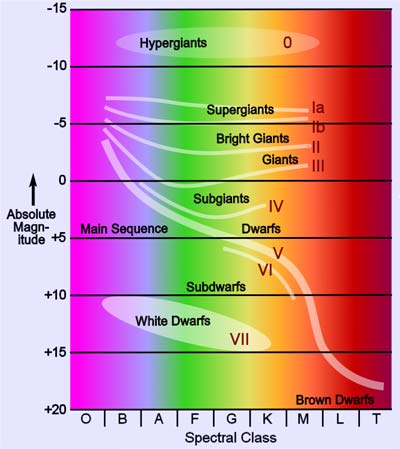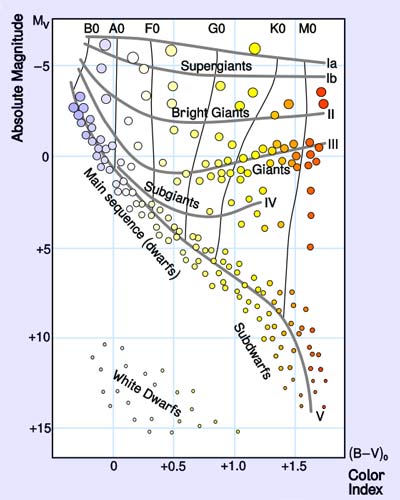Supergiants are among the most massive stars. In the Hertzsprung-Russell diagram they occupy the top region of the diagram. In the Yerkes spectral classification supergiants are class Ia (most luminous supergiants) or Ib (less luminous supergiants). They typically have bolometric absolute magnitudes between -5 and -12. The most luminous supergiants are often classified as hypergiants of class 0.

Hertzsprung-Russell diagram (*) |
Supergiants can have masses from 10 to 70 solar masses and brightness from 30,000 up to hundreds of thousands times the solar luminosity. They vary greatly in radii, usually from 30 to 500, or even in excess of 1000 solar radii. The Stefan-Boltzmann law dictates that the relatively cool surfaces of red supergiants radiate much less energy per unit area than those of blue supergiants; thus, for a given luminosity red supergiants are larger than their blue counterparts.
Because of their extreme masses they have short lifespans of only 10 to 50 million years and are mainly observed in young cosmic structures such as open clusters, the arms of spiral galaxies, and in irregular galaxies. They are less abundant in spiral galaxy bulges, and are rarely observed in elliptical galaxies, or globular clusters, most of which are believed to be composed of old stars.
Supergiants occur in every spectral class from young blue class O supergiants stars to highly evolved red class M supergiants. Rigel, the brightest star in the constellation Orion is a typical blue-white supergiant, whereas Betelgeuse and Antares are red supergiants.
The modelling of supergiants is still an active area of research and is made more difficult by issues such as stellar mass loss. Rather than modelling individual stars, the latest trend has been to model clusters of stars and then compare the distribution of the resulting models with the observed supergiant distributions in galaxies like the Magellanic Clouds.

The Hertzsprung-Russell diagram shows the relationship between absolute magnitude, luminosity, classification, and effective temperature of stars. (*)
The first stars in the universe are thought to have been considerably brighter and more massive than the stars in the modern universe. These stars were part of the theorized population III of stars. Their existence is necessary to explain observations of elements other than hydrogen and helium in quasars.
Most type II supernova progenitors are thought to be red supergiants. However, the progenitor for Supernova 1987A was a blue supergiant. It is believed that it was a red supergiant before losing its outer layers to its strong stellar wind.
Currently, the largest known stars in terms of physical size, not mass, brightness or luminosity, are the supergiants VY Canis Majoris, VV Cephei, V354 Cephei, KW Sagitarii, KY Cygni, and μ Cephei (the Garnet Star).
See also
* Giant star
* Red giant
* Red supergiant
* Blue supergiant
* Hypergiants
* List of stellar angular diameters
Retrieved from "http://en.wikipedia.org/"
All text is available under the terms of the GNU Free Documentation License

